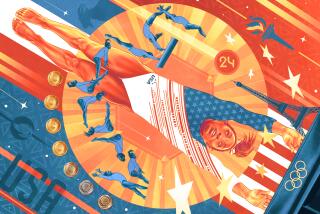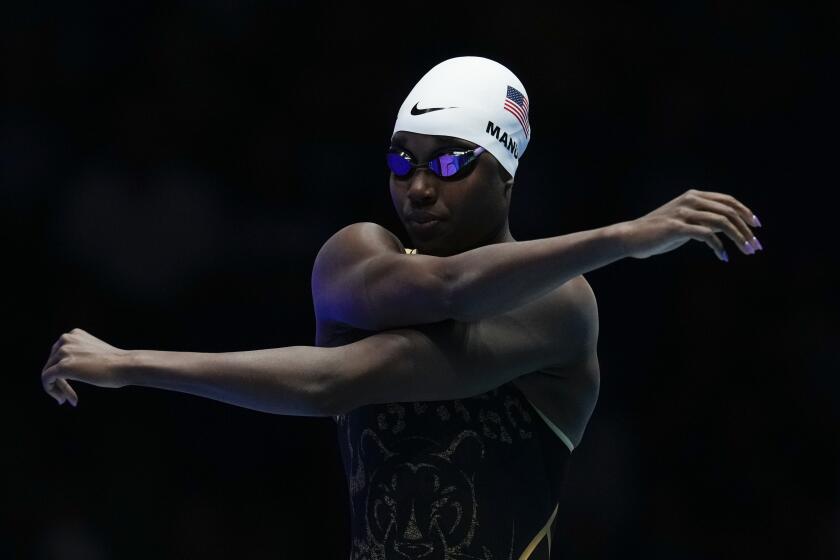THE TIES THAT BIND : In Zany Chain Race, the Team That Stays Together Can Win
When most of the world was watching Neil Armstrong step out of the Apollo 11 lunar module and onto the moon--July 20, 1969--there were 4,473 people at the Figure 8 races at Ascot Park.
That gives an indication of the loyalty of the thrill-seeking fans who spend most Sunday evenings watching a group of daredevils playing chicken at the Ascot intersection. If there had been a chain race, there might have been another thousand people there.
At Formula One tracks, a chain is gold and is worn around a driver’s neck.
At Ascot, a chain is 3/8-inch steel, 19 to 21 feet and is secured between two beat-up cars, refugees from a neighborhood junkyard. Usually, 8 to 10 pairs of cars compete in a chain race.
The jalopies, chained together, usually race 10 laps over a watered-down Figure 8 course, slithering and sliding through the mud, hoping not to break the chain or get it hopelessly tangled in the wheels of one of the cars.
If the chain breaks, or disconnects for any reason, it’s an automatic disqualification.
Winning seems almost incidental. Surviving is most important. And it’s not all that easy.
To properly understand a Figure 8 intersection, imagine Hollywood and Vine without stop signs, drivers daring each other as they dart across in front of oncoming cars.
A chain race has an added element of suspense as the second car also has to get through the intersection without getting slammed in the side--but it’s the driver in the first car who makes the decision.
The guy in the rear can be a sitting duck if his partner guesses wrong.
“You can get beat up, physically, in these things,” said Robert Rice of Lawndale, a body-shop mechanic who is a chain-race veteran at 21. “That’s why most drivers are young.”
Rice is a second generation chain racer. His father, Jim Rice, drove in them when Rob was a teen-ager.
“The most important thing is to keep slack out of the chain,” Rice explained. “Once the front wheels (of the trailing car) run over the chain, or if another car runs over the chain at the crossover, it’s usually all over.
“Once a chain gets tangled, it’s like tying a granny knot. You can’t get it untied.”
The only place to get experience is in a race. It’s not the sort of thing you can do driving along Manchester Avenue. Besides, if you did, you’d still have to stop for the stop signs. There are no stop signs at Ascot.
Walt Conkey and Jim Pattscholl, a couple of guys from Anaheim, tried chain racing for the first time the other night. Before they were through, their chain had slung the rear car out like it was cracking the whip. Before either could react, the two cars had swapped ends.
“Wow, that was wilder than a roller coaster,” Conkey said after he climbed out of his dilapidated Chevy.
Most of the cars are sponsored by wrecking companies, which isn’t surprising because most of the cars come straight from wrecking yards, and when the race is over, most of them are hauled away by wreckers.
“What you need most is a strong engine,” Rice said. “You can find a car for $50 or $60 in a junkyard and then you put the engine in it, put on mud tires and haul it to the race. The one thing you want in a chain race or in a (demolition) derby is to have the car keep running. That’s why you need a sound engine that you can take in and out of the junkers.”
Before the cars get to the track, though, a spray paint can is a necessity. In addition to a number sprayed on the door panel, there can be messages.
Andy Crager’s car proudly displays “I Love Mom and Dad. Thanks.” Mark Lee, obviously a Laker fan, announced, “Lakers Win” on his No. 65. Dorothy and Eddie Awtrey, who both race, have “Tender Touch Tow” on both their cars.
Racer hangouts are popular, too, such as McKee’s Lounge, Key Largo Lounge and Tommy’s Coffee Shop. Putting their name on the car might be worth at least a bologna sandwich and a cup of hot coffee. Maybe even a beer after the race.
Some of the cars have “For Sale” sprayed on the sides, or scrawled across the window. No prices are given.
For some reason, undoubtedly not understood by animal lovers, many cars have stuffed animals tied to rollbars, taped to the windows or hanging from the rear-view mirror.
The rules are simple. Two are most important.
Rule 1: “Open to any American manufactured full size passenger car and all full size all metal station wagons. No convertibles, hearses, ambulances, panel or pickups.”
Rule 12: “All cars must be removed from Ascot premises immediately after the race.”
Rice and Billy Altfather, the Ascot chain-race champions, used a Cadillac Eldorado in front and an Olds in the rear, both ’75 models, for their last win.
“You want the bigger car in front,” Rice said. “The guy in front wants to keep his car straight so that the guy in the rear can see what’s going on. That’s not easy in the mud, when you’re making four turns every lap and the mud keeps flying up in your face.
“The rear driver has to have a feeling of what to expect because he wants to keep the chain as taut as he can. The worst thing is to have the front car start too fast and jerk the rear car. You get a lot of broken chains that way.”
Top speed, if the two are really hooked up, is 35 to 40 m.p.h., but if conditions are extremely muddy, the speeds drop considerably. And speeds sliding sideways are not computed.
Altfather, 30, an automotive electrician from Hawthorne, is the Godfather of destruction at Ascot.
“I’ve been racing for nearly 15 years, mostly at Ascot and Eddie (Awtrey) and I have been doing chain races and demos (demolition derbys) as long as I can remember,” Altfather said. “I wanted to be a professional race driver when I started, but that takes money, more money than I’ve got, so I have fun racing at Ascot. It’s a great weekend hobby.”
Altfather and Rice collected $200 for their latest win. On a good night, with a big crowd and a large entry, the winning pair might pocket $500.
Like most chain racers, Altfather also competes in Figure 8 and bomber oval races.
About 10 years ago, in his first race as a novice on the Ascot oval, Altfather had a new car, was the fastest qualifier and won the trophy dash, heat and main event. Then he raced in the expert main and finished sixth.
His most memorable feat, however, came on foot.
Ken Mackow, a motorcycle daredevil who was once in the Guinness Book of Records for the longest ride through a tunnel of fire, was performing his stunt at Ascot for the 1977 Fourth of July program.
“The crowd wasn’t very impressed and they started booing him,” Altfather recalled. “He was really stalling around and when he finally rode through the tunnel, which wasn’t more than a couple of car lengths, the crowd booed pretty good.
“I looked at the crowd, pointed to myself, then pointed to the tunnel, then back to the crowd, then to myself again. I had them really pumped up, so I just took off and ran through the tunnel.
“Mr. (track owner J.C.) Agajanian was not amused when he heard about it.”
Neither were the insurance brokers. Altfather was reprimanded, but his reaction was to come back the next week and moon the officials. This got him banned from the track for three weeks.
“It was no big deal. The tunnel was big enough to fit a good-sized car, and there wasn’t much fire left.”
When Saugus Speedway demolition drivers challenged Ascot to a soccer-style game in which the ball was a large, round water buoy and cars were used to “kick” the ball, Altfather captained the Ascot team of himself, Rice, Awtrey, Tony Zaffino and Danny Queener.
“We went up there not knowing how to play the game, but we beat them both times,” Altfather said. “We go to Saugus for demos, too, but they’re a lot tougher up there than at Ascot because they’re on asphalt.
“You get hit on asphalt and you know it. You can really get jarred. At Ascot, on the dirt, the cars slide and lose a lot of the impact. The hits aren’t near as hard.”
Two weeks ago, when Rusty Gendre was on the victory stand to accept the trophy for his first bomber oval win after 10 years of trying, the trophy girl was escorted to the ceremony by what appeared to be a gorilla.
It was Altfather.
Saturday night, the Fourth of July stock car show at Ascot will end with its monthly demolition derby. Altfather can’t wait.
“I like the derby the best,” he said. “It’s fun destroying cars.”
More to Read
Go beyond the scoreboard
Get the latest on L.A.'s teams in the daily Sports Report newsletter.
You may occasionally receive promotional content from the Los Angeles Times.






